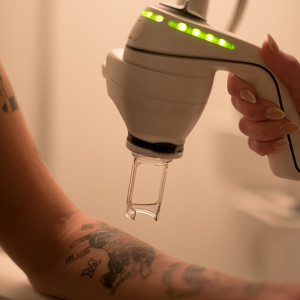June 4, 2022
When ink went mainstream in World War II, it cemented the relationship between tattoos and masculinity


CHAPTER 5
Tattooing was practiced by soldiers on both sides of the war, and for similar reasons.
The war didn’t just introduce millions of American men to tattooing while they were in service, as you’d expect. The American Navy actually caused a big spike in tattooing before these men had even joined the forces: “As military enlistment escalated prior to World War II, the American Navy caused another inadvertent boom in tattooing,” according to Collectors Weekly. “Decades before, the U.S. government had issued a pamphlet with a passage requiring incoming recruits to fix any obscene tattoos, which primarily meant drawings of nude women. During the ’40s, this passage was a godsend for tattoo artists, as young men scrambled to censor their bodily markings so they could enlist.”
Publish Date in article
"Even official U.S. Navy posters incorporated the ubiquitous nautical tattoos, like this image from the “Loose Lips Sink Ships” campaign of the ’40s,” according to Collectors Weekly.
Tattooing was practiced by soldiers on both sides of the war, and for similar reasons: To show off rank and accomplishments. To demonstrate group identity. And on a deeper level, to use body art as a way of communicating “the pain, suffering, anguish, determination, commitment and will to overcome any circumstance,” writes WWII Ink. The relationship between tattoos and masculinity was firmly established.
"Before going to war in the 1940s, many individuals wouldn’t think of getting a tattoo. However, even Air Force pilots would eventually use tattoos for unit and rank recognition. In addition (tattoos) were used in order to identify that particular individual as being a real US soldier,” the article states.
Publish Date in article


Sailor Jerry became particularly influential during the war. Based in Hawaii, where Pearl Harbour was bombed, his signature designs “combining stylistic elements from Japanese, American and European techniques,”writes Collectors Weekly. It is in Hawaii where he found a whole new audience and officially went mainstream.
Publish Date in article
“After many of the soldiers came home from battle in World War II, almost all of them would have some form of tattoo,” according to WWII Ink.
Once WWII was in full swing, “millions of clean-cut American men had the — uh, opportunity — to visit the South Pacific, just near Honolulu, where former-Navy- man-turned-tattoo-artist Norman Collins (a.k.a. Sailor Jerry) slung ink at his shop,” according to Refinery 29.
Publish Date in article
There was a more sinister side to the use of tattoos in this era. Tattoos were also a common way of branding prisoners and identifying those who’d been captured. The Nazis “used tattooing as a weapon of dehumanization and control,” according to Gemma Angel, writing for University College London’s blog. “From May 1940, prisoner numbers were introduced for all concentration camp prisoners deemed capable of work at the Auschwitz concentration camp complex.”












